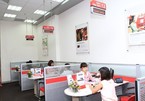With competitive advantages in interest rates, foreign banks in Vietnam are boosting consumer loans as the business segment is forecast to keep rising and bring greater growth opportunities for lenders this year.
 |
|
Shinhan Bank has focused on consumer lending after buying ANZ’s retail banking arm.
|
Interest rates for individual loans at some Vietnamese banks are tending to inch up as the banks have to restructure capital sources to meet the central bank’s regulation on reducing the ratio of short-term capital for medium-long-term loans from 40% to 37% this year. The rates for home loans at domestic banks are ranged from 10.5% to 12% per year.
Meanwhile, many foreign banks, with strong finance status backed by their parent companies, are offering loans with lower interest rates to lure borrowers.
Malaysia’s Hong Leong Bank Vietnam, for example, is offering home loans at interest rate of 7.75% per year and car purchase loans at rate of 7.5% per year.
Indovina Bank, the first joint venture bank in Vietnam between Taiwan’s Cathay United Bank and VietinBank, is also launched a preferential loan program for borrowers buying real estate and cars, with fixed interest rate of 7.99% per annum.
Meanwhile, South Korea’s Shinhan Bank, which is currently the largest foreign bank in Vietnam after acquiring ANZ’s retail banking arm in 2017, is offering unsecured personal consumer loans at rate of 20-21% per year.
According to foreign banks, they have decided to boost consumer finance loans as the business segment is forecast to maintain double digit growth this year.
Duong Duc Hung, general director of Hong Leong Bank Vietnam, said that consumer credit had grown strongly in recent years, at 30-60% per year. Therefore, it will not be surprising if the lending segment continues to grow by 20% this year.
According to Hung, Vietnam’s GDP growth is maintained at a high level, leading to the increase in personal income and the strong development of the middle class, which is a key factor for the increase of consumer credit growth.
Meanwhile, the proportion of consumer credit to the total credit is just about 20%, showing a lot of room for growth, Hung said.
“Vietnam is Hong Leong Bank’s priority market because of its great growth opportunities, especially in the retail segment. The launch of HLB Connect digital banking application late last year is a step in Hong Leong Bank’s strategy to expand retail segment in Vietnam,” Hung said.
High profit margin
Consumer finance credit is always attractive for both domestic and foreign banks, as well as financial companies, because its profit margin is higher than that of institutional lending.
According to Ho Chi Minh City Securities Company (HSC), FE Credit, a consumer lending company of VPBank, made up 50% of VPBank’s overall profit in recent years. Similarly, HD Saison, consumer lending arm of HDBank, also accounted for a third of HDBank’s total profit.
Nguyen Hoang Minh, deputy director of the State Bank of Vietnam’s Ho Chi Minh City branch, said that in the period of 2016-2018, the average growth of outstanding loans for finance and consumption reached 36% per year.
Minh forecast that the high growth rate will continue to be maintained this year, as well as the following years and this has attracted financial companies and banks.
However, he said, bad debts in the consumer financing sector tend to increase, especially in consumer finance companies, due to easy lending conditions.
In a bid to mitigate risk and fraud, the central bank is tightening regulations on the consumer finance market, limiting the maximum amount of cash loan to 30% of total loans. Hanoitimes
Anh Hong

Foreign banks may return soon
The completion of the sale of Vietcombank stake to foreign buyers in early 2019 and of BIDV at the end of last year may bode well for a comeback of foreign banks to Vietnam in 2020.

‘Big four’ banks turn into ‘big two’
With Vietcombank making up 40 percent of total profit of four state-owned banks, the competition among the ‘big four’ banks has been reduced to the ‘big two’.
 Foreign banks have decided to boost consumer finance loans as the business segment is forecast to maintain double digit growth this year." itemprop="description" />
Foreign banks have decided to boost consumer finance loans as the business segment is forecast to maintain double digit growth this year." itemprop="description" />